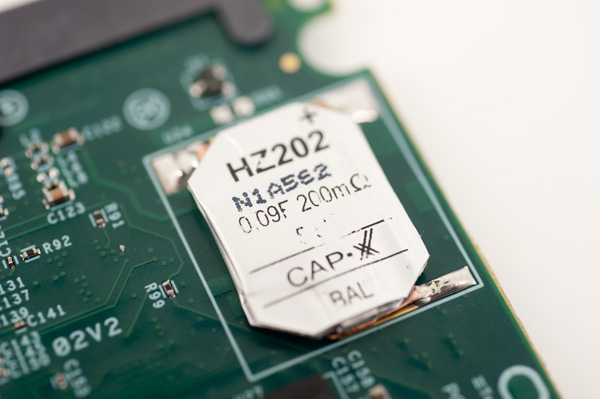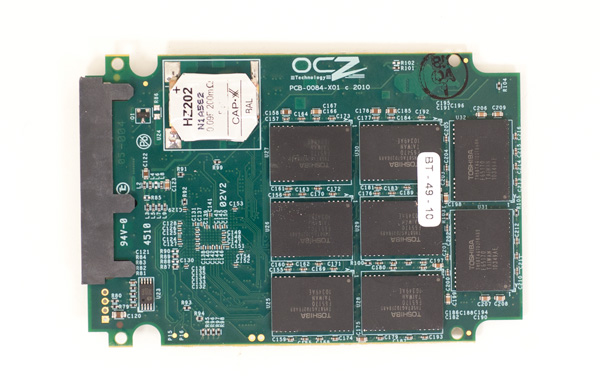OCZ Vertex 3 Pro Preview: The First SF-2500 SSD
by Anand Lal Shimpi on February 17, 2011 3:01 AM ESTToday: Toshiba 32nm Toggle NAND, Tomorrow: IMFT 25nm
The Vertex 3 Pro sample I received is a drive rated at 200GB with 256GB of NAND on-board. The SF-2682 controller is still an 8-channel architecture and OCZ populates all 8 channels with a total of 16 NAND devices. OCZ selected Toshiba 32nm Toggle Mode MLC NAND for these early Vertex 3 Pro samples however final shipping versions might transition to IMFT 25nm. The consumer version (Vertex 3) will use IMFT 25nm for sure.
Each of the 16 NAND devices on board is 16GB in size. Each package is made up of four die (4GB a piece) and two planes per die (2GB per plane). Page sizes have changed. The older 34nm Intel NAND used a 4KB page size and a 1MB block size. For Toshiba's 32nm Toggle NAND pages are now 8KB and block size remains unchanged. The move to 25nm will finally double block size as well.
Remember from our earlier description of SandForce's architecture that its data redundancy requires a single die's worth of capacity. In this case 4GB of the 256GB of NAND is reserved for data parity and the remaining 66GB is used for block replacement (either cleaning or bad block replacement). The 200GB drive has a 186GB formatted capacity in Windows.
This is a drive with an enterprise focus so the 27.2% spare area is not unusual. You can expect the consumer versions to set aside less spare area, likely at little impact to performance.

The 0.09F supercap, a feature of the enterprise level SF-2500 controller. This won't be present on the client Vertex 3.
The Vertex 3 Pro is still at least a month or two away from shipping so pricing could change, but right now OCZ is estimating sales at between $3.75 and $5.25 per GB. The client focused Vertex 3 will be significantly cheaper - I'd estimate somewhere north (but within range) of what you can currently buy Vertex 2 drives for.
| OCZ Vertex 3 Pro Pricing | |||||
| 100GB | 200GB | 400GB | |||
| MSRP | $525.00 | $775.00 | $1350.00 | ||
| Cost per GB | $5.35/GB | $3.875/GB | $3.375/GB | ||
Both the Vertex 3 and Vertex 3 Pro are expected to be available as early as March, however as always I'd be cautious in jumping on a brand new controller with brand new firmware without giving both some time to mature.












144 Comments
View All Comments
abrar - Friday, February 18, 2011 - link
"In this particular drive the user (who happened to be me) wrote 1900GB to the drive (roughly 7.7GB per day over 8 months) and the SF-1200 controller in turn threw away 800GB and only wrote 1100GB to the flash. This includes garbage collection and all of the internal management stuff the controller does."how did you calculate this data ?
have you used any special software?
douglaswilliams - Friday, February 18, 2011 - link
Anand,Will these very fast read rates speed up virus scans?
Thank you for being technical and thorough,
Douglas
Qapa - Saturday, February 19, 2011 - link
ALL disk reads are this fast, so of course this will have an impact in virus scanning.But mostly, it will have an impact that your system is faster, although those resource hogs (virus scanning programs) are running - and yes, their bottleneck were reading the files from the disk.
semo - Saturday, February 19, 2011 - link
I've noticed that MSE is mostly limited by CPU and it isn't multithreaded so even worse notebooks where the CPU freq. might be lowerjoeld - Friday, February 18, 2011 - link
I don't believe any of the SF-1200 makers actually supported encryption on the drive, so the password was basically blank. Are the folks bringing the SF-2500 to market actually going to support disk passwords so that full-disk encryption requirements for laptops will be met? Software based full disk encryption is just too slow and flawed when paired with SSD drives...faster - Saturday, February 19, 2011 - link
Props to OCZ for leading the performance market on multiple levels.Looking at the prices of these new high performance SSDs, including the upcoming offerings from Intel, the OCZ Revodrive X2 is looking like a value. With Revodrive's read/write of 740/720, even this next generation of drives doesn't even come close. Now that newegg sells the 240GB x2, on sale, for $540 ($679 not on sale), it is a better bang for the buck than the new drives. The revodrive is a product that has been out for a while and is available right now. If you have the open PCIe slot, it seems like a no-brainer to pick the X2.
croc - Sunday, February 20, 2011 - link
Sadly, (well maybe not so sadly) we Aussies are not allowed gun ownership. There are exceptions, but generally not... So the final conclusion, "2011 may be the year to finally pull the trigger." does not really apply. However, maybe the right year to finally purchase an SSD, time (and further testing) will tell.MamiyaOtaru - Monday, February 21, 2011 - link
time doesn't "tell" anything. It's an abstract concept. I mean if you're going to take issue with idioms..Qapa - Sunday, February 20, 2011 - link
It would also be interesting to have in the benchs:- 1 "normal" 7200 HDD
- 1 "normal" 5400 laptop HDD
This would be interesting to compare since, most people do not own Velociraptors and this way we would be able to better know the system improvement on buying an SSD, and convincing other people - like our bosses - to upgrade our computers at work as well :)
compvter - Monday, February 21, 2011 - link
@faster Thats because they have two (old) sf controllers in the card. Think about the speeds they get with two of these (sf-2000 family) i would guess it will be around 1GB/s (read&write). At least current revodrives lack trim support so, that might be deal breaker for some ppl.